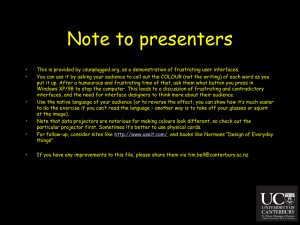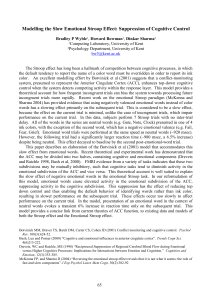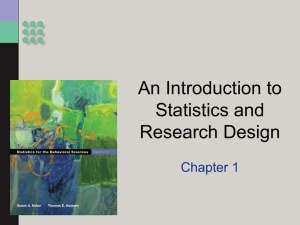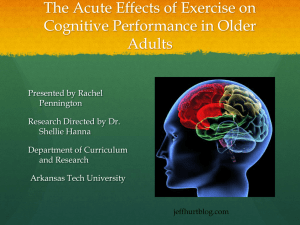Document
advertisement
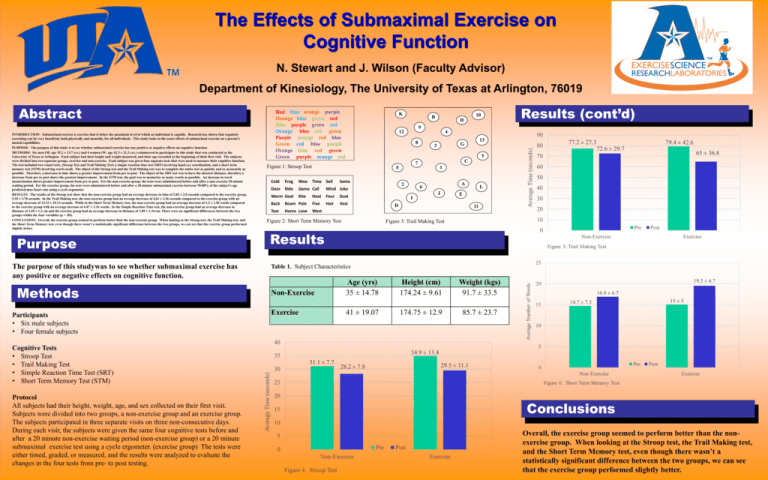
The Effects of Submaximal Exercise on Cognitive Function N. Stewart and J. Wilson (Faculty Advisor) Department of Kinesiology, The University of Texas at Arlington, 76019 Abstract INTRODUCTION: Submaximal exercise is exercise that is below the maximum level of which an individual is capable. Research has shown that regularly exercising can be very beneficial, both physically and mentally, for all individuals. This study looks at the acute effects of submaximal exercise on a person’s mental capabilities. PURPOSE: The purpose of this study is to see whether submaximal exercise has any positive or negative effects on cognitive function. METHODS: Six men (M; age 35.2 ± 13.7 yrs.) and 4 women (W; age 42.3 ± 21.3 yrs.) volunteered to participate in this study that was conducted at the University of Texas at Arlington. Each subject had their height and weight measured, and their age recorded at the beginning of their first visit. The subjects were divided into two separate groups, exercise and non-exercise. Each subject was given four separate tests that were used to measure their cognitive function. The test included two visual tests, (Stroop Test and Trail Making Test) a simple reaction time test (SRT) involving hand eye coordination, and a short term memory test (STM) involving word recall. The object of the Stroop test and the Trail Making test was to complete the entire test as quickly and as accurately as possible. Therefore, a decrease in time shows a greater improvement from pre to post. The object of the SRT test was to have the shortest distance, therefore a decrease from pre to post shows the greatest improvement. In the STM test, the goal was to memorize as many words as possible. An increase in word memorization shows greater improvement from pre to post. For the non-exercise group, the tests were administered before and after a non-exercise 20 minute waiting period. For the exercise group, the tests were administered before and after a 20 minute submaximal exercise between 70-80% of the subject’s age predicted max heart rate using a cycle ergometer. RESULTS: The results of the Stroop test show that the non-exercise group had an average decrease in time of 2.83 ± 2.0 seconds compared to the exercise group, 5.35 ± 3.78 seconds. In the Trail Making test, the non-exercise group had an average decrease of 4.61 ± 3.26 seconds compared to the exercise group with an average decrease of 14.33 ± 10.13 seconds. While in the Short Term Memory test, the non-exercise group had an average increase of 2.2 ± 1.56 words compared to the exercise group with an average increase of 4.47 ± 3.16 words. In the Simple Reaction Time test, the non-exercise group had an average decrease in distance of 1.69 ± 1.2 cm and the exercise group had an average decrease in distance of 1.89 ± 1.34 cm. There were no significant differences between the two groups within the four variables (p > .05). CONCLUSION: Overall, the exercise group seemed to perform better than the non-exercise group. When looking at the Stroop test, the Trail Making test, and the Short Term Memory test, even though there wasn’t a statistically significant difference between the two groups, we can see that the exercise group performed slightly better. Purpose The purpose of this studywas to see whether submaximal exercise has any positive or negative effects on cognitive function. Methods Participants • Six male subjects • Four female subjects Red blue orange purple Orange blue green red Blue purple green red Orange blue red green Purple orange red blue Green red blue purple Orange blue red green Green purple orange red K 8 Frog Nine F Time Sell Same Door Ride Game Call Mind Joke Worm Goal Kite Heat Four Dust Back Roam Pole Five Hair Vest Tear Home Love West Figure 2: Short Term Memory Test 2 4 5 C 1 A 6 I 13 G 3 7 Results (cont’d) 10 H 9 12 Figure 1: Stroop Test Cold B J D L E 11 Figure 3: Trail Making Test Results Table 1. Subject Characteristics Non-Exercise Age (yrs) 35 ± 14.78 Height (cm) 174.24 ± 9.61 Weight (kgs) 91.7 ± 33.5 Exercise 41 ± 19.07 174.75 ± 12.9 85.7 ± 23.7 Cognitive Tests • Stroop Test • Trail Making Test • Simple Reaction Time Test (SRT) • Short Term Memory Test (STM) Protocol All subjects had their height, weight, age, and sex collected on their first visit. Subjects were divided into two groups, a non-exercise group and an exercise group. The subjects participated in three separate visits on three non-consecutive days. During each visit, the subjects were given the same four cognitive tests before and after a 20 minute non-exercise waiting period (non-exercise group) or a 20 minute submaximal exercise test using a cycle ergometer. (exercise group) The tests were either timed, graded, or measured, and the results were analyzed to evaluate the changes in the four tests from pre- to post testing. Conclusions Overall, the exercise group seemed to perform better than the nonexercise group. When looking at the Stroop test, the Trail Making test, and the Short Term Memory test, even though there wasn’t a statistically significant difference between the two groups, we can see that the exercise group performed slightly better.
